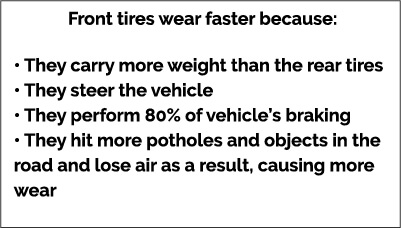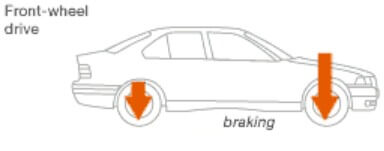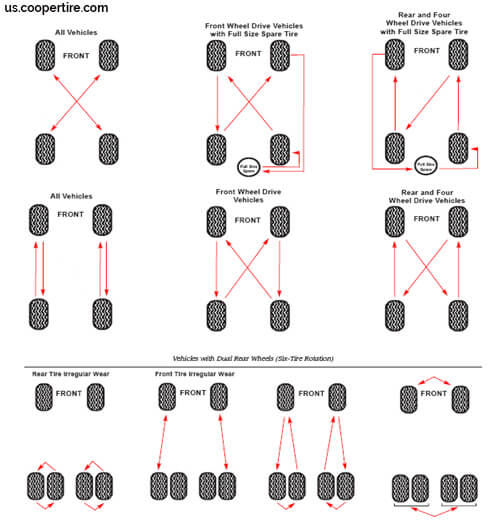Is tire rotation really necessary
Here’s why tire rotation is important
Tires wear unevenly on every vehicle, making tire rotation important to maintain the best traction and stopping power and increase the life of your tires. Here’s an explanation of why tires wear unevenly, how often you should have them rotated, along with a cost/benefit analysis.
Tire rotation is important to reduce uneven wear
It doesn’t matter whether you drive a front wheel drive, rear wheel drive,  all-wheel drive, or four wheel drive vehicle: 60% of the vehicle’s weight is carried by the front tires. That fact alone means the front tires wear faster than the rear tires. Plus, the front tires perform all steering maneuvers, causing more rubber to “scrub” off the tire in turns. Also, 80% of the vehicle’s braking is done by the front tires since the vehicle weight shifts forward during a stop. When you factor in the extra weight and wear from steering and braking, it’s no wonder that front tires wear faster than rear tires.
all-wheel drive, or four wheel drive vehicle: 60% of the vehicle’s weight is carried by the front tires. That fact alone means the front tires wear faster than the rear tires. Plus, the front tires perform all steering maneuvers, causing more rubber to “scrub” off the tire in turns. Also, 80% of the vehicle’s braking is done by the front tires since the vehicle weight shifts forward during a stop. When you factor in the extra weight and wear from steering and braking, it’s no wonder that front tires wear faster than rear tires.
Finally, front tires are subject to more impacts from potholes and parking lot barriers. Those impacts can result in a  momentary air pressure loss that causes under inflation. Under inflated tires wear faster than tires that have the correct air pressure. See this post to understand why the correct air pressure is so important to tire life.
momentary air pressure loss that causes under inflation. Under inflated tires wear faster than tires that have the correct air pressure. See this post to understand why the correct air pressure is so important to tire life.
Why not skip costly tire rotations and just replace the front tires when they wear out?
New tires generate the highest rolling resistance simply because they have more rubber that has to flex with each tire rotation. That high flex rate generates heat in the rubber which can lower its life. However, new tires also have deep grooves between the tread blocks that literally pump air and water out from the center of the tire, moving it to the side shoulders and fanning it away from the tire. Tires rely on this built-in cooling system to keep the rubber from degrading.
But as the tread blocks wear, they’re less able to move air and water. When that happens, the tread wear accelerates due to the heat. Since front tires run hotter than rear tires due to the extra weight, steering, and braking functions, they’re more susceptible to this kind of accelerated wear as the tread block approach their end of life.
Skipping tire rotation service simply accelerates the wear on the front tires. How much? See the cost/benefit section of this article.
What tire rotation accomplishes
Tire rotation spreads the wear evenly across all four tires, increasing overall tire life and safety. In addition, tire rotation evens out any wear patterns that have developed in the tires.
What are typical tire rotation patterns?
The cost/benefit analysis of tire rotation
Many tire shops sell a mounting and lifetime tire rotation and balancing package for about $20 per tire. However, most independent repair shops and dealers charge about $25 each time they rotate your tires.
If you buy the lifetime rotation/balance package from a tire store, you’ll spend an extra $80 up-front on a set of four tires. If you have a dealer rotate your tires every 5,000 miles at $25 each time you’ll spend $300 during the life of a set of 4 60,000 mile tires.
Failing to rotate your tires can shorten the life of the front tires by 50%.
Tire rotation is important because it saves you money
Let’s use a 2010 Mazda CX-7 crossover/SUV for our comparison. It’s typical of many late crossover/SUV model vehicles with low profile tires. A low cost tire for this vehicle costs around $240.
Cost per mile with tire store rotation package
4 tires at $240 each plus $20/each rotation/balance add on. $1,040 ÷ 60,000 miles = 0.0173/mile
Cost per mile with rotations done every 5,000 miles at $25 each
4 tires at $240 each plus $300 for rotation. $1,260 ÷ 60,000 miles = 0.0210/mile
Cost per mile with NO rotations
4 tires at $240 =$960, plus 2 new tires at 30,000 to replace the worn out front tires. +$480= $1,440
$1,440 ÷ 60,000 miles= 0.024/mile
The net result is that failure to rotate your tires actually costs you 39% more.
In addition, buying tires from a dealer or independent repair shop and paying for rotation each time will cost you 21.5% more than buying the same tires from a tire store that offers a lifetime rotation/balance package for $20/tire.
Additional benefits of tire rotation
• Longest tread life
• Better handling in turns and better braking due to even tire tread depth at all four wheels
• Lower overall cost
How often should you rotate your tires?
As a general rule, you should rotate your tires every 5,000 to 7,000 miles, depending on the advice of the tire manufacturer or tire store service manager. Choose the lower tire rotation interval if you routinely carry a heavy load in your vehicle, have a heavy foot and like jack-rabbit starts, and like to brake hard.
©, 2016 Rick Muscoplat
Posted on by Rick Muscoplat
